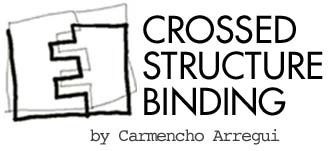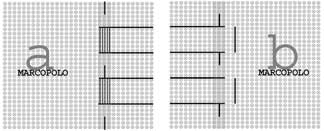

CROSSED STRUCTURE BINDING MARCOPOLO
Click here to see CSB images.
In the past some bindings were specially conceived for travelling: geographical itineraries, doctor's manuals, currency books and books of hours for pious ladies. Even today painters carry a sketchbook with them and writers slip a notebook in their pocket for fleeting thoughts. The Crossed Structure Binding Marcopolo can easily be converted into a travelling book...
CSB Marcopolo
I will assume that the book is ready to be bound and that all prior steps have been carefully carried out. The description refers to a full-leather binding with clean-cut edges (handmade paper, parchment and vellum can also be used). I will not work to any particular dimension, assuming the template to be clear enough for each person to adapt it to a given size.
The two templates are almost symmetrical apart from small differences. At first sight it is hard to imagine the two parts of this binding crossing at the spine, each side having a complete series of straps without cut-outs and no evidence of a counterpart. The vertical half-cuts in the centre of the spine make the crossing possible. These cuts should be made when the text-block is sewn and the thickness of the spine is known. The sewing remains hidden.
Cutting the back cover
To see the cutting of the straps, go back to Cutting the straps in the index.
The two sides of the cover are cut separately.
Cut the back cover following side a of the template.
The back has two parts: the cover itself and the straps that can be of different lengths according to the use to which the book is to be put (Variations below). For a binding with five straps the book block should be sewn to the second and the fourth.
The sewing
To see the fixing of the cover to the sewing frame go to
A sewing frame in the index.
The sewing is carried out with kettle stitches in the normal way, to see sewing 1, go back to CSB sewings in the index. The thickness of the thread should provide enough 'swell' in the spine to allow you to round the book. I always round by hand, not with a hammer. After the sewing, the spine is still accessible and can be lined if desired.
Cutting the front cover
Cut the front cover following side b of the template. The front has two parts: the cover itself and the straps that can be of different lengths according to the use to which the book is to be put (see Variations below).
Two vertical slots should be cut in the cover, 5mm away from the base of the second and fourth straps.
The crossing
After sewing, the sewn straps are slipped out through the vertical slots of the front cover and are overlaid by the straps opposte.
The crossing of the remaining straps is made possible by the half cuts in the centre of the spine area at both sides. Cut the vertical half cuts. The cuts are complementary, being inserted one into the other. When you make the vertical half cuts it is very easy to get confused, give them some thought before cutting.
Variations:
The straps can be cut to align or can be different lengths.
The CSB Marcopolo may easily become a traveller's book that can be fastened and hung up. The two upper straps pinched together make a very firm hanger. The elongated middle straps of both sides can be used as fasteners. These alternatives have to be planned and calculated right from the beginning.
If you want to download the text, templates and sewings of this binding, go to Download CSB in the index.